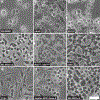Generating and working with Drosophila cell cultures: Current challenges and opportunities
- PMID: 30561900
- PMCID: PMC6450750
- DOI: 10.1002/wdev.339
Generating and working with Drosophila cell cultures: Current challenges and opportunities
Abstract
The use of Drosophila cell cultures has positively impacted both fundamental and biomedical research. The most widely used cell lines: Schneider, Kc, the CNS and imaginal disc lines continue to be the choice for many applications. Drosophila cell lines provide a homogenous source of cells suitable for biochemical experimentations, transcriptomics, functional genomics, and biomedical applications. They are amenable to RNA interference and serve as a platform for high-throughput screens to identify relevant candidate genes or drugs for any biological process. Currently, CRISPR-based functional genomics are also being developed for Drosophila cell lines. Even though many uniquely derived cell lines exist, cell genetic techniques such the transgenic UAS-GAL4-based RasV12 oncogene expression, CRISPR-Cas9 editing and recombination mediated cassette exchange are likely to drive the establishment of many more lines from specific tissues, cells, or genotypes. However, the pace of creating new lines is hindered by several factors inherent to working with Drosophila cell cultures: single cell cloning, optimal media formulations and culture conditions capable of supporting lines from novel tissue sources or genotypes. Moreover, even though many Drosophila cell lines are morphologically and transcriptionally distinct it may be necessary to implement a standard for Drosophila cell line authentication, ensuring the identity and purity of each cell line. Altogether, recent advances and a standardized authentication effort should improve the utility of Drosophila cell cultures as a relevant model for fundamental and biomedical research. This article is categorized under: Technologies > Analysis of Cell, Tissue, and Animal Phenotypes.
Keywords: CRISPR; Drosophila; RNA interference; authentication; cell culture.
© 2018 Wiley Periodicals, Inc.
Figures



References
Publication types
MeSH terms
Substances
Grants and funding
LinkOut - more resources
Full Text Sources
Molecular Biology Databases

